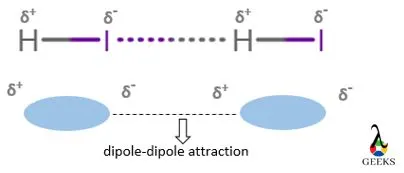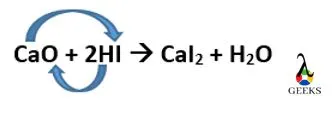Calcium oxide is a widely used and one of the oldest chemical compounds that show reactions with strong acids such as hydroiodic acid. Let us look into how their reaction occurs.
Calcium oxide (CaO), on interaction with hydroiodic acid (HI), gives salt and water. CaO often known as quicklime, is an odorless, caustic, alkaline chemical with high stability. At room temperature, it appears as a white to greyish crystalline powder. HI is a colorless aqueous solution of hydrogen iodide and water.
Both HI and CaO are water-soluble compounds. This article shall discuss how the reaction between these two compounds takes place as well as their different characteristics.
What is the product of HI and CaO
Calcium iodide (CaI2) and water (H2O) are formed as products when calcium oxide (CaO) is reacted with hydroiodic acid (HI).
CaO (aq) + 2HI (aq) —> CaI2 (aq) + H2O (l)
What type of reaction is HI + CaO
HI + CaO is a neutralization reaction, also known as an acid-base reaction, wherein HI is a strong acid, and CaO is a weak base.
How to balance HI + CaO
The balanced chemical equation for HI + CaO using hit and trial approach is as follows:
CaO + 2HI —> CaI2 + H2O
Following are the steps to balance the reaction scheme mentioned above:
- The total number of atoms for each element on both sides of the unbalanced reaction is counted.
| Atoms | Reactant Side | Product Side |
|---|---|---|
| Calcium | 1 | 1 |
| Iodine | 1 | 2 |
| Oxygen | 1 | 1 |
| Hydrogen | 1 | 2 |
- Hydrogen and iodine atoms are equated by multiplying compound HI by coefficient 2, thereby balancing the whole reaction.
- Thus, the balanced chemical reaction is as follows,
- CaO + 2HI —> CaI2 + H2O
- The elements on the reactant and product sides are now balanced, with one calcium atom, 2 iodine atoms, 1 oxygen atom and 2 hydrogen atoms on both sides of the reaction.
HI + CaO Titration
Titration of HI + CaO falls under the group of strong acid weak base titration and can be performed as follows.
Apparatus and Chemicals Required
Burette, Pipette, Conical flask, Measuring flask, Burette stand, Beaker, Funnel, Distilled water, Hydroiodic acid, Calcium oxide
Indicator
This titration is performed with a methyl orange indicator to mark the solution’s endpoint with a physical transformation.
Procedure
- A standard CaO solution is made by dissolving a few grams of it in distilled water.
- After washing and rinsing the burette, it is filled with standardized CaO solution.
- A pipette is used to transfer the HI solution into a clean, rinsed titration flask, and 2 drops of methyl orange is added to it.
- The CaO solution is added to the titration flask drop-by-drop. The flask is rapidly shaken until the solution changes color to light pink. This color shift signifies the reaction’s end point.
- Thereafter, the final reading is recorded, and the amount of CaO solution used to neutralize the Hl solution is calculated.
- The previous steps are repeated until three concordant readings are achieved.
- The volume of the required chemical is estimated using the formula M1V1 = M2V2.
HI + CaO Net Ionic Equation
The net ionic equation for HI + CaO is:
Ca2+ (aq) + O2- (aq) + 2H+ (aq) + 2I– (aq) = Ca2+ (aq) + 2I– (aq) + 2H+ (aq) + O2- (aq)
Following are the steps to derive the net ionic equation:
- The complete balanced chemical equation is first noted with their respective physical states.
- CaO (aq) + 2HI (aq) = CaI2 (aq) + H2O (l)
- The only compounds or atoms in the aqueous phase are split into their respective ions.
- Thus, the overall net ionic equation for the given reaction is as follows,
- Ca2+ (aq) + O2- (aq) + 2H+ (aq) + 2I– (aq) = Ca2+ (aq) + 2I– (aq) + 2H+ (aq) + O2- (aq)
HI + CaO Conjugate Pairs
HI + CaO has the following conjugate acid-base pairs:
- The conjugate base of HI after donating in the reaction is I–.
- The conjugate base of H2O is OH– whereas the conjugate acid of H2O after accepting a proton is H3O+.
- The conjugate pair for CaO is not obtained as it is a neutral ionic compound.
HI and CaO Intermolecular Forces
- Dipole-dipole interactions and london dispersion forces are the intermolecular forces of attraction involved between the HI molecules.
- Ionic forces act as the intermolecular forces of attraction between the calcium cation and oxide anion in CaO.

HI + CaO Reaction Enthalpy
The reaction enthalpy of HI + CaO is -114.98 kJ/mol (approximate value).
| Compounds | Moles | Enthalpy of Formation, ΔH⁰f (kJ/mol) |
|---|---|---|
| HI (aq) | 2 | -56.829 |
| CaO (aq) | 1 | -557.33 |
| CaI2 (aq) | 1 | -500.17 |
| H2O (l) | 1 | -285.8 |
- The enthalpy of a reaction is calculated using the formula: ΔH⁰f (reaction) = ΣΔH⁰f (products) – ΣΔH⁰f (reactants)
- Standard enthalpy of reaction = [1×(-500.17) + 1×(-285.8)] – [2×(-56.829) + 1×(-557.33)] kJ/mol = -114.98 kJ/mol.
Is HI + CaO a Buffer Solution
HI + CaO does not act as a buffer solution due to the presence of a strong acid, HI, which directly gets neutralized with the base, CaO, resulting in salt formation.
Is HI + CaO a Complete Reaction
HI + CaO is a complete reaction yielding two complete and stable products, calcium iodide (CaI2) and water (H2O).
Is HI + CaO an Exothermic or Endothermic Reaction
The reaction HI + CaO is exothermic in nature since the change in reaction enthalpy is negative, resulting in heat liberation during the reaction process.
Is HI + CaO a Redox Reaction
HI + CaO is not a redox reaction because no change in oxidation states is observed for the reactants and products involved in the given reaction.
Is HI + CaO a Precipitation Reaction
HI + CaO is not a precipitate reaction because CaI2 produced is highly soluble in water and, thus, leaves behind no precipitate.
Is HI + CaO Reversible or Irreversible Reaction
HI + CaO is an irreversible reaction as the formed products cannot be reverted to give the original reactants under the same reaction conditions.
Is HI + CaO Displacement Reaction
HI + CaO is an example of double displacement reaction wherein the cationic parts (H+ and Ca2+), and anionic parts (O2- and I–) of the reactants swap their places to form the products.

Conclusion
Calcium iodide and water are obtained from the reaction between hydroiodic acid and calcium oxide. The reaction is categorized as an irreversible exothermic reaction. CaI2 is a white deliquescent solid used in photography widely.

Hello, I am Padmakshi Kotoky working as a Subject Matter Expert on this platform. I have completed my post-graduation from the Institute of Chemical Technology, Mumbai. I have always found Chemistry an intriguing subject and enjoy exploring more on it. I would like to utilize this platform to explain the subject in an easy and precise manner making it simpler for the readers to understand the concepts with clarity. I engage myself in Singing, Dancing, and nature photography during my leisure time.
Let’s connect through LinkedIn – https://www.linkedin.com/in/padmakshi-k-b54679132